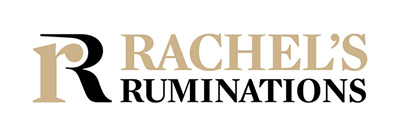The beauty of the Rhaetian Railway in Switzerland
My husband and I took a quick trip to Switzerland recently, partly to visit our son, who is studying in Bern, but also to take the Rhaetian Railway through the Alps to Italy and back.
I think Switzerland might just be the most beautiful country in the world. Given that I’ve been to 74 different countries (I just counted), that’s saying a lot.
The problem is that it’s really hard to capture that beauty in a photograph, or rather it is for me, as an amateur photographer. So take this as a bit of an apology for the photos in this article, but also as an incentive to travel in Switzerland: it’s even better than these photos show!
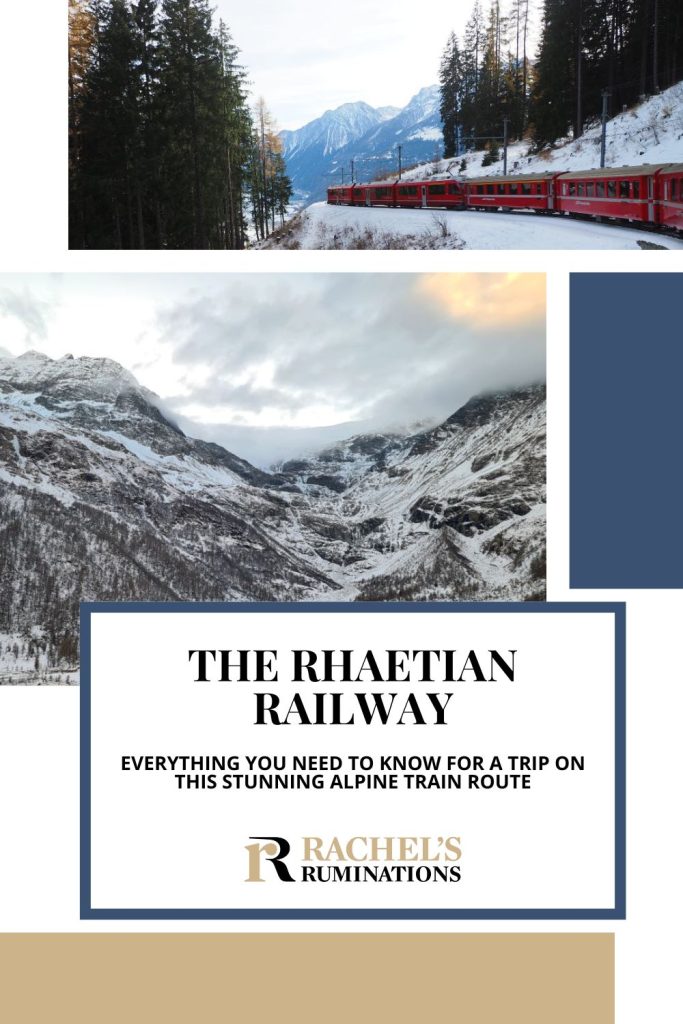
Disclosure: Rhaetian Railway sponsored my tickets for this ride, but for my husband they only provided the seat reservation in one direction. Nevertheless, I try to stay as unbiased as I can, and the Rhaetian Railway has no say about what I write.
And another disclosure: This article contains affiliate links. Making a purchase through an affiliate link will mean a small commission for this website. This will not affect your price.
Swiss trains and the Rhaetian Railway
Switzerland has an excellent train system. The trains are modern, clean and in good repair. So are the tracks, at least judging by how smooth the ride is. They’re almost always on time, down to the minute. And using their SBB mobile app makes planning travel very easy. The only disadvantage of their system is that it’s quite expensive, but I’ll get to that in my tips at the end of this article.
The Swiss train system is operated by a number of regional companies, and the Rhaetian Railway operates routes in the south of the country. Two railway lines operated by this regional company, now merged, are a UNESCO site, officially called “Rhaetian Railway in the Albula/Bernina Landscapes.”
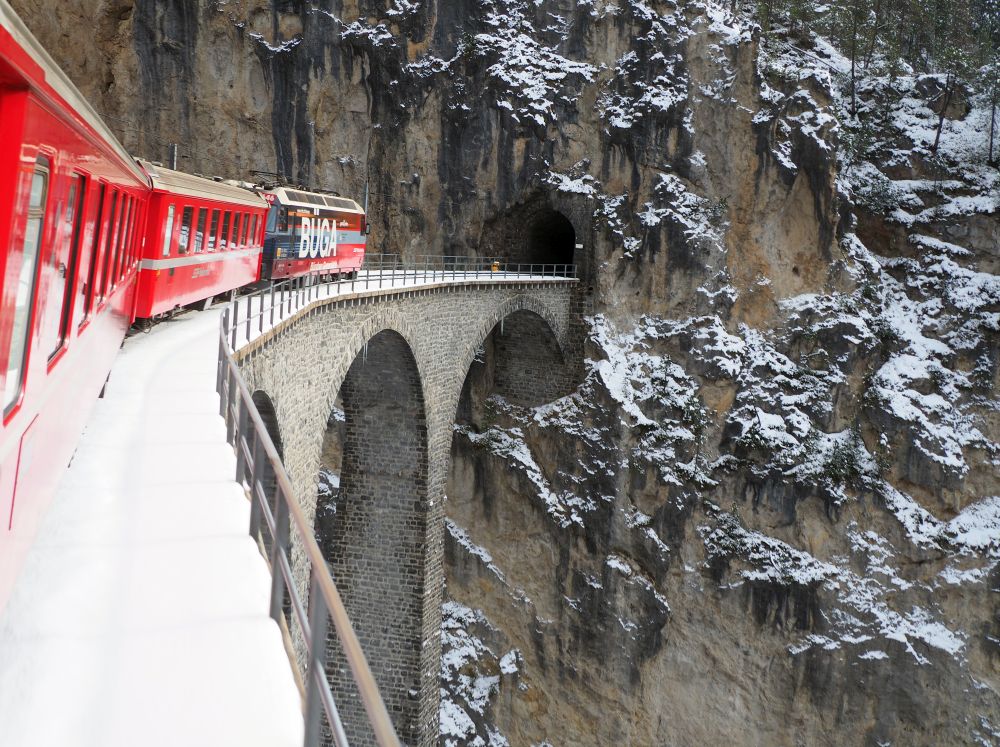
They are a marvel of engineering. Together they include 55 tunnels (some are galleries) and 196 viaducts and bridges, with a maximum slant of 7%. The longest tunnel on the route is 5.9 kilometers long (3.6 miles). The builders of these railway routes did some truly innovative things to make them possible: things like taking the track in full circles (sometimes inside mountains!) to move trains up or downhill. And these viaducts, bridges and tunnels are still used today, 115 years later. The trains are modern, but the routes are original.
Our experience on the Rhaetian Railway
Anyway, we took the 122-kilometer (76 miles) route twice: once from Chur in Switzerland to Tirano, just over the border in Italy, on a regular regional train operated by Rhaetian Railways. Then, the next day, we traveled back along the same route, this time on a special tourist train called the Bernina Express.
The route includes so many breathtaking views I found myself saying “Wow!” a lot. Particularly as the train passes through each of those many tunnels, whatever new view reveals itself as you emerge is another wow-moment. We took a lot of pictures and, looking at them afterwards, none of them captured it.
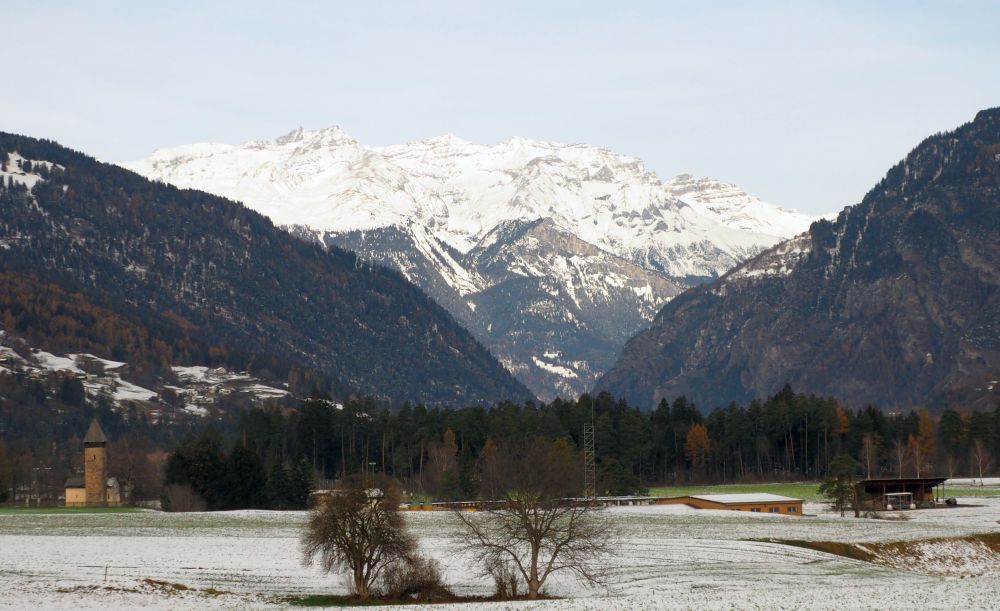
The train moves slowly for most of the route, even on the downhills. Sometimes a voice over a loudspeaker identifies points of interest as you pass them. You wind your way up the sides of mountain valleys, often doubling back so that as you emerge from a tunnel you’re surprised to see essentially the same view, but higher up. The places where the route makes a full 360-degree spiral are mostly inside tunnels, so you aren’t aware of them. Near the Tirano end of the route, though, one of the full circles is outdoors – a great opportunity to photograph or film the train itself.
The train stops at small towns and a few isolated spots where there doesn’t seem to be much of anything but a station and a restaurant between mountain peaks. These mountains are, in the summer, a popular place for hiking, and there are ski stations in some places in winter, but when we went in November it was pretty empty at these stops. For many of the stations, the train will only stop if you request it by pushing a button at the end of your train car.
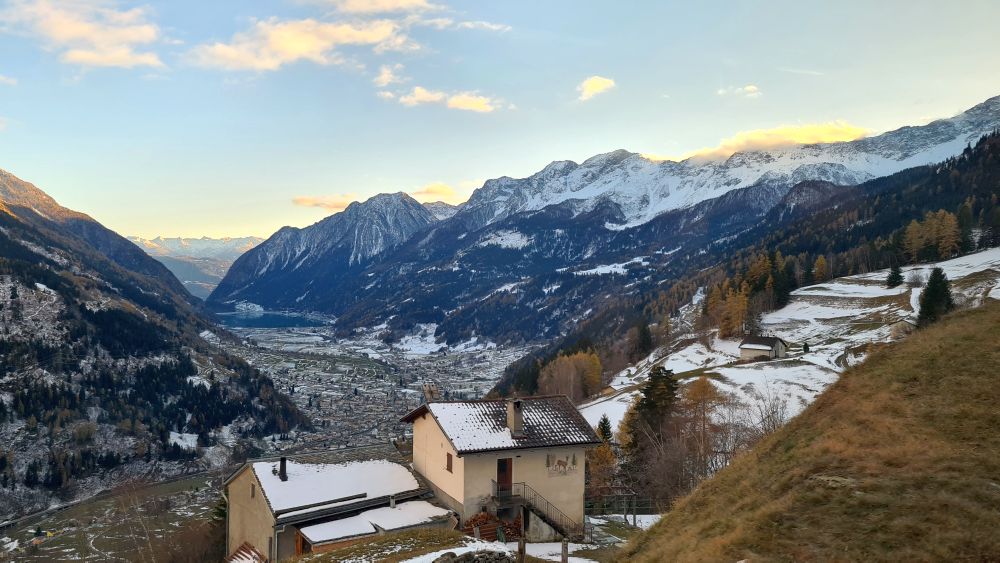
What’s the difference between the regional train and the Bernina Express tourist train?
There are a number of differences which may influence which you choose to take.
Changing trains
The regional train, if you want to take it all the way from Chur to Tirano, requires two changes of train. These aren’t difficult and involve very little waiting, but it means it’s less restful. The Bernina Express, on the other hand, goes all the way between Chur and Tirano, stopping at only the set stations, not the “by request” stations. Not having to get off makes it more relaxing. The regional train takes 4-4.5 hours, but the Bernina Express is no faster. It takes about 4.5 hours.
The view and photography
On the Bernina Express the views are better because the windows are much bigger. You don’t have to lean toward the window and peer upwards to glimpse a whole nearby mountain. It’s all visible from your seat.
The disadvantage of this is that the curved glass can interfere with your photography. I ended up giving up on my proper camera and instead used my mobile phone, pressing it against the glass to eliminate glare. That works, but only allows you to point it straight out at a right angle to the glass.
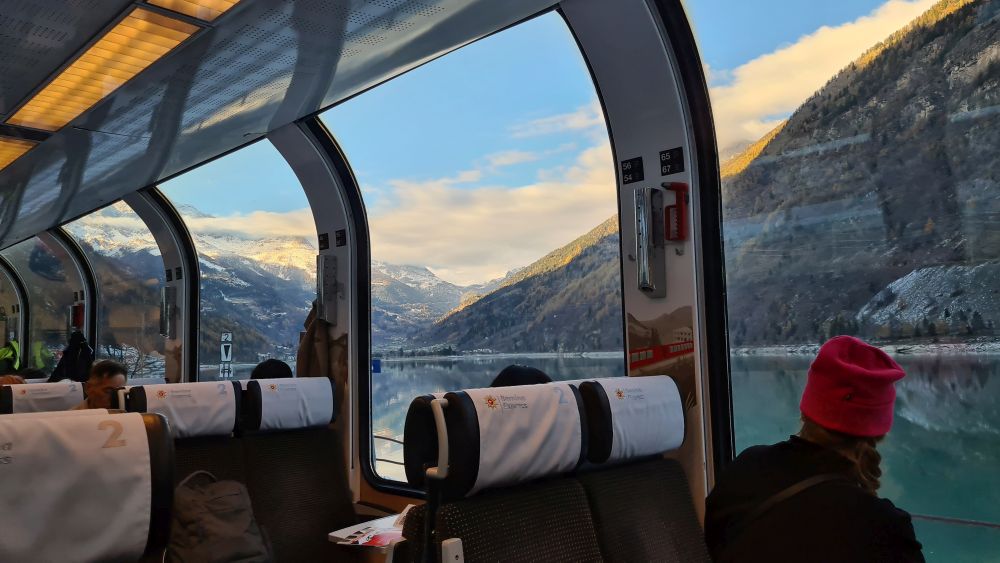
At the ends of each car of the train, near the exit doors, there is a single window that you can open. You can always stand there and take your pictures out the window. However, they’re only on one side of the car.
On one of the regional trains we took – the one from Chur to Samedan – there was a compartment specifically for photography. Rather than seats, it had a sort of low, upholstered wall down the middle for people to lean against. On both sides were large windows that could be rolled down at the push of a button. I spent most of that part of the route standing at one window or the other, trying to get some decent pictures. It was great that they provided that, but it was a) cold and b) a bit annoying having to jockey for position with lots of Instagrammers taking far too long trying to get perfect shots of each other leaning out windows.
In any case, the regional trains also have windows that can be opened at the end of every car. They’re right next to the exit doors, so sometimes I just used them. And on some of the regional trains all the windows can be opened. The problem was that it was cold out – about 32°F or 0°C when we left, and colder at higher elevations – and opening those windows might meet with fierce resistance from fellow passengers, so I didn’t try.
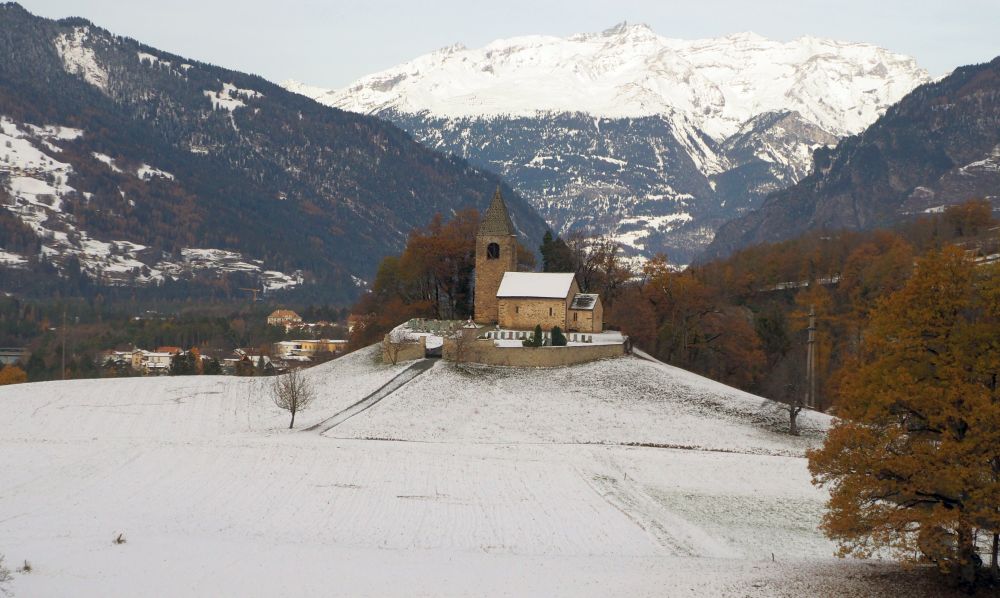
Perks of the Bernina Express
Since the Bernina Express is about seeing the views, not about getting from A to B, the Rhaetian Railway adds a few perks. A website linked to it shows where you are in realtime and tells all sorts of interesting information about various locations and views as you pass them. You can check your elevation and know ahead of time when something worth photographing is coming up.
Each passenger receives a small souvenir box shaped like a Bernina Express train car, inside of which you’ll find some delicious milk chocolates. We also received a box of some sort of herb tea. There’s some pretty classy catering available if you want more: things like a sausage and cheese plate or a bottle of wine.
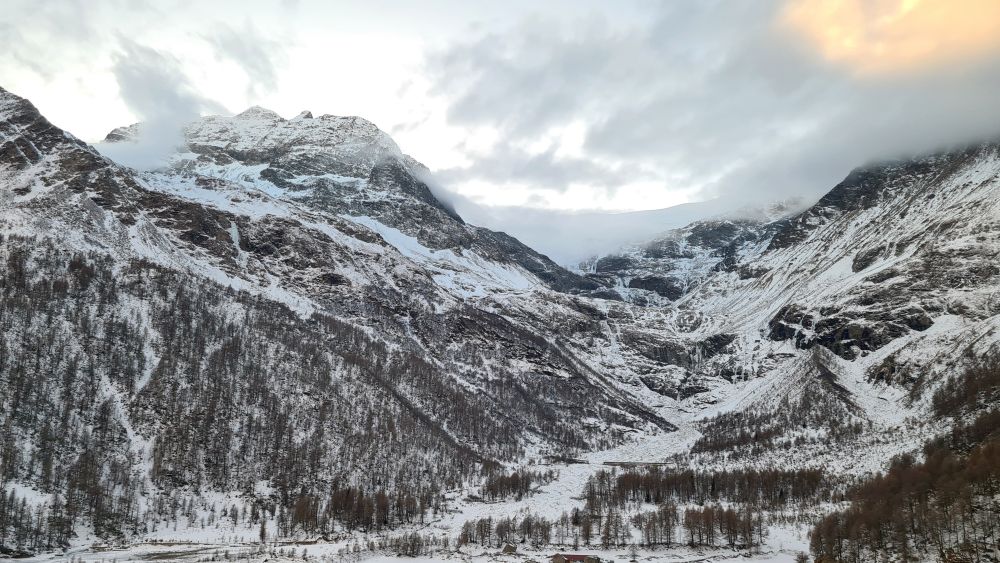
So which Rhaetian Railway trip is better?
That depends on what you want. You have to reserve your Bernina Express seats ahead of time, and you want to make sure you get window seats.
On the regional train you’re likely to get better photos, if that is something that matters to you.
I’d venture to say that the Bernina Express is the better option if the schedule works for you and the price doesn’t put you off. While you’ll see the same views in either case, you’ll see them better on the panoramic train. What I found was that, since I wasn’t going to be able to get great pictures through the glass, I just relaxed into it and enjoyed the ride. I still took some pictures, but didn’t stress over them.
Also, on the regional train you have to transfer a couple of times, at least on the route we did between Chur and Tirano. It’s not much of a burden because the connections are so well-timed, but it’s nice if you can take a direct train and settle in.
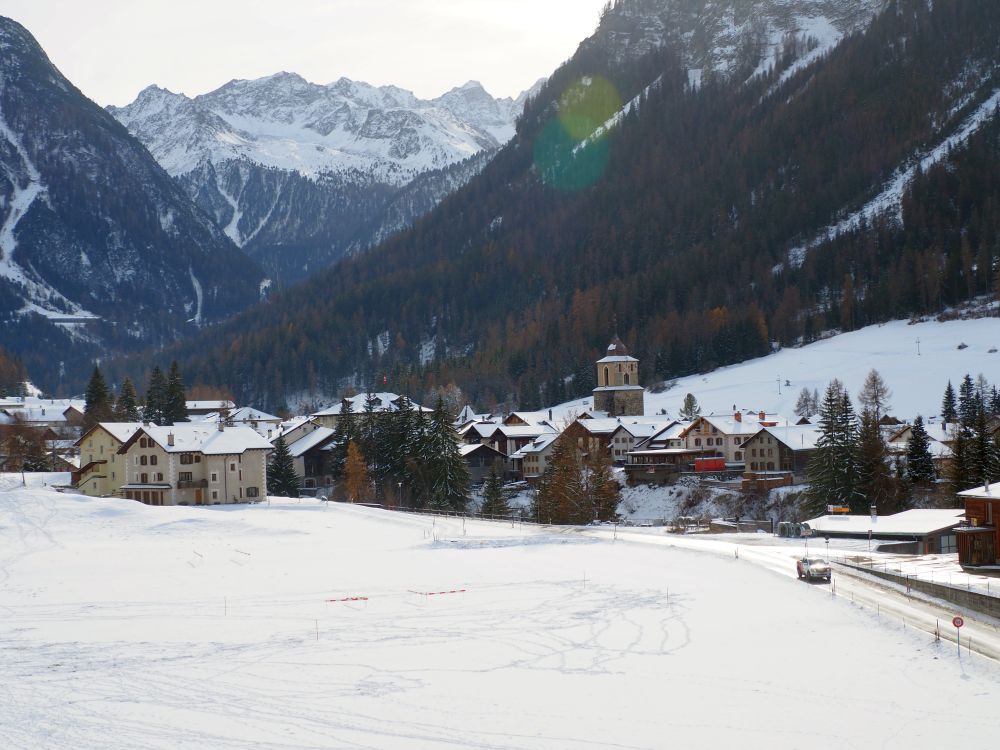
On the other hand, because the regional trains run throughout the day and you haven’t reserved seats, it’s much less of a problem to step off for an hour or two somewhere on the route and get back on when you’re ready. On the Express, you can get off, but since they don’t run often – twice a day between May and October, once a day the rest of the year – you might have many hours or even overnight to wait. And since reservations are necessary, you’d have to plan that stop ahead of time.
The regional doesn’t have much in the way of food or drink for sale, while the options are distinctly better on the Express. Since our connections were so short and we hadn’t brought any food, we ended up getting off the regional train at Poschiavo. We spent an hour there until the next train in order to get something to eat. That’s not a complaint, though; it’s also a pretty place with an interesting old town center.
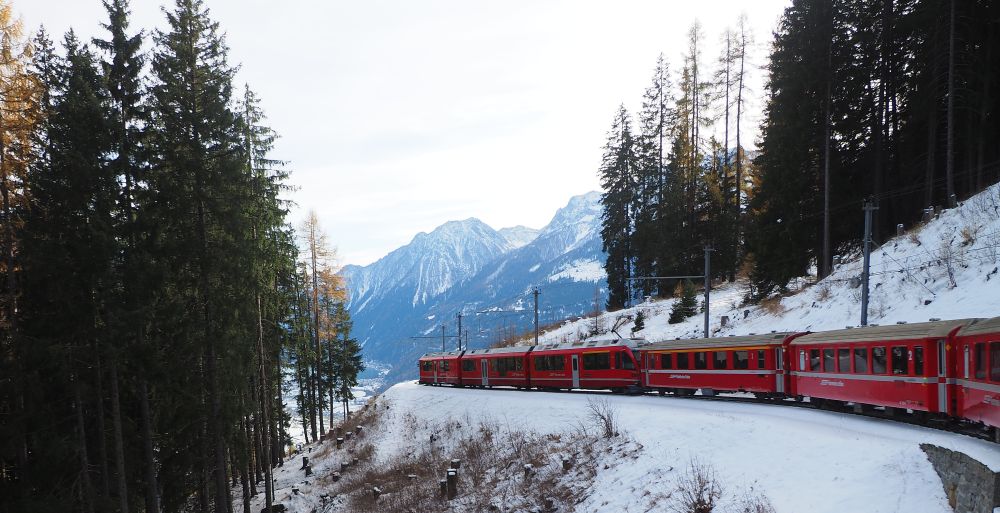
Tips for traveling on the Rhaetian Railway
The trip is 4-4.5 hours long, so I’d suggest not trying to do both ways in one day. If your whole goal is to take this line, then take it over two days, staying a night at either end. Or use a one-way trip as an excuse to travel into Italy for a while.
If you opt for the regional trains, take some food and drink along with you.
Going south, choose a seat on the right-hand side of the train. You’ll get views from both sides, but more of the views are on the right. Going north, sit on the left.
In Tirano, there are two train stations right next to each other: the RFI station and the RhB. The RhB is the one you want if you’re heading back into Switzerland. The RFI station is for the Italian trains.
If you’re travelling primarily in Italy but want to see the Swiss Alps for a day, day trips to the Rhaetian Railway are available from Como and from Milan.
Another Swiss train line I’d recommend is the route between Luzern and Interlaken. This so-called “express” train trundles its way up the mountains, passing bright blue glacial lakes and small villages of chalets in the valleys, all framed by dramatically craggy mountains. Read my article about the week I spent with UnTours in a village along this route.
Possible stops along the way
Since the regional trains run often – once an hour or more during the day – you can get off one and get on the next at any stop. I’d suggest Alp Grüm, which, at 2,091 meters elevation (6,860 feet), is not the highest stop on the line. That honor belongs to Ospizio Benina (2,253 meters or 7,392 feet), the highest mountain crossing by train in all of Europe. But the dramatic views from Alp Grüm make it worth a stop. There’s no village there: just the station, which has a restaurant and a small hotel, unreachable except by train.
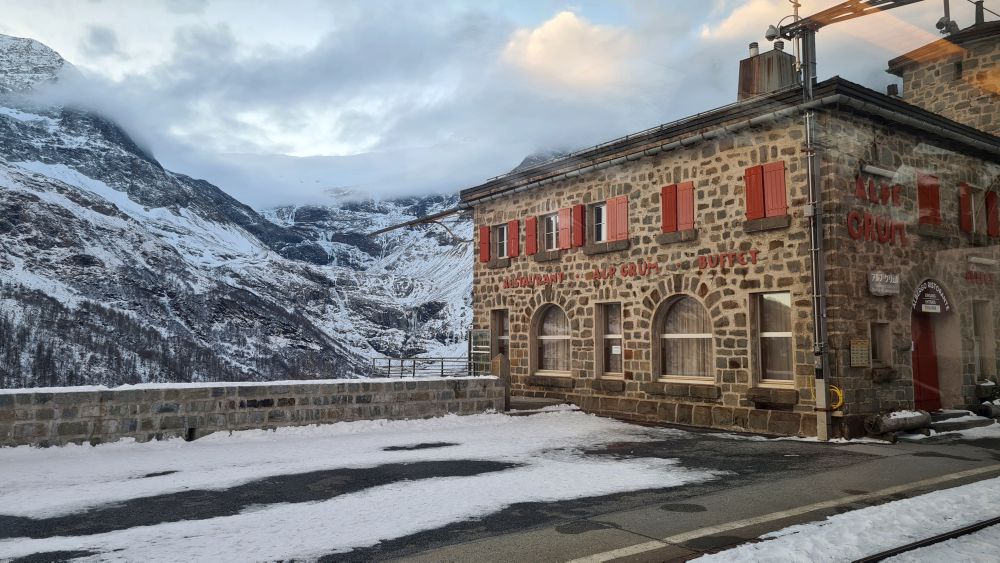
Another possible stop would be in Bergün/Bravuogn, where one of the old station buildings is now home to a railway museum called Bahnmuseum Albula. It covers the history and construction of the railway, as well as information about model railways. I haven’t been, but it sounds quite kid-friendly.
Prices on the Rhaetian Railway
For both trains, you can use a regular train ticket. However, for the Bernina Express you have to pay an additional required seat reservation fee of CHF36 in the high season (May to October) and CHF32 the rest of the year.
A regular full-price train ticket from Chur to Tirano or vice-versa, as of this writing, is CHF66 for 2nd class or CHF113 for 1st class one way, double that for round trip. You pay this no matter which train you take.
However, the train fare for either train can be cheaper if you book ahead. The SBB SwissRail website offers “supersaver” fares for some routes on some days. More are available the earlier you buy them on their site. It also has “Saver day passes” which are cheaper the earlier you buy them too. Make sure, if you buy online, that you’re not buying a ticket that accompanies a half-fare card. (I found the SwissRail website rather confusing because it kept assuming I had a half-fare card.) No matter which ticket you’re using, the Bernina Express will always have the extra seat reservation charge. You can make the reservation and pay through their website.
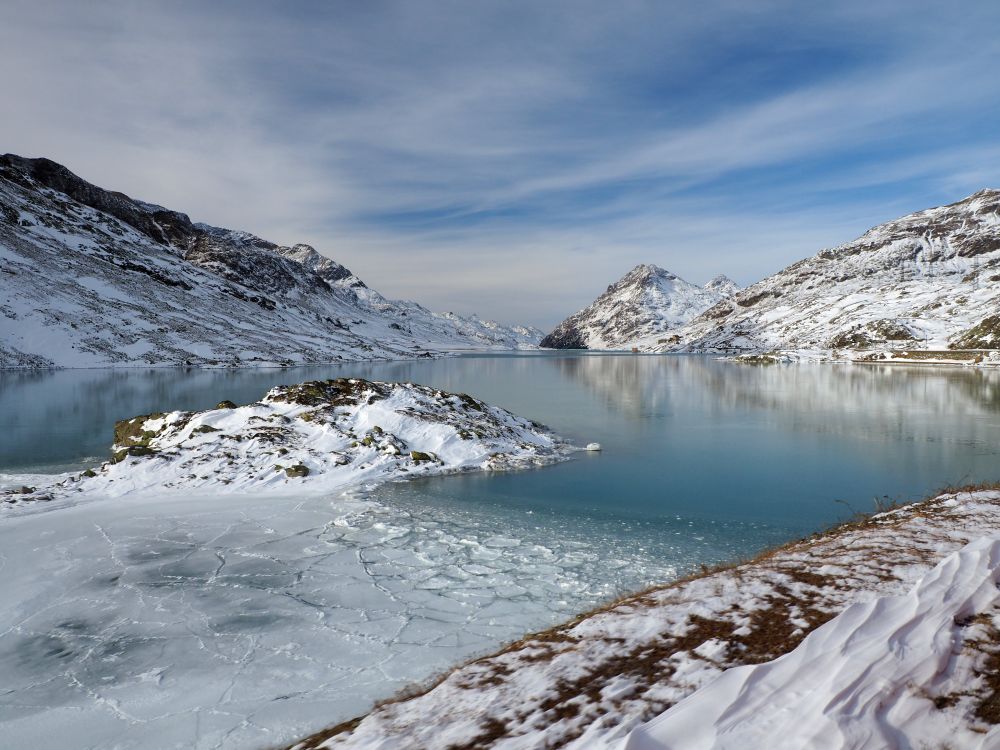
Tirano, Italy: Accommodations and food
Tirano has a picturesque old section that’s worth at least a stroll, with a few palaces, churches and museums worth seeing. Unfortunately, in November when we were there, not much was open, but we were only there for an overnight stay anyway.
We stayed at Eco Rooms&Breakfast. I chose it because of its good reviews and the fact that it’s very near the train station. It was lovely, especially considering the very reasonable price. Our “Tirano Suite” at the top of an older building was very large, with balconies on two sides and an enormous bathroom. It was well-appointed, clean, quiet and comfortable.
Tirano has plenty of other hotels. Use the map below to find accommodations. The pin marks the train station.
The day we arrived in Tirano was my husband’s birthday, so I had booked a meal at the hotel’s restaurant called Merizzi. It serves “tasting menus,” though the portion sizes were distinctly bigger than a taste. The food was elegant and delicious and, incidentally, I loved the mellow jazz vocals they played in the background. Even if you don’t stay at this hotel, think about eating at this restaurant. They also serve breakfast for hotel guests and are open for lunch as well.
Have you taken this or any other of the scenic train routes in Switzerland? Add a comment below!
My travel recommendations
Planning travel
- Skyscanner is where I always start my flight searches.
- Booking.com is the company I use most for finding accommodations. If you prefer, Expedia offers more or less the same.
- Discover Cars offers an easy way to compare prices from all of the major car-rental companies in one place.
- Use Viator or GetYourGuide to find walking tours, day tours, airport pickups, city cards, tickets and whatever else you need at your destination.
- Bookmundi is great when you’re looking for a longer tour of a few days to a few weeks, private or with a group, pretty much anywhere in the world. Lots of different tour companies list their tours here, so you can comparison shop.
- GetTransfer is the place to book your airport-to-hotel transfers (and vice-versa). It’s so reassuring to have this all set up and paid for ahead of time, rather than having to make decisions after a long, tiring flight!
- Buy a GoCity Pass when you’re planning to do a lot of sightseeing on a city trip. It can save you a lot on admissions to museums and other attractions in big cities like New York and Amsterdam.
Other travel-related items
- It’s really awkward to have to rely on WIFI when you travel overseas. I’ve tried several e-sim cards, and GigSky’s e-sim was the one that was easiest to activate and use. You buy it through their app and activate it when you need it. Use the code RACHEL10 to get a 10% discount!
- Another option I just recently tried for the first time is a portable wifi modem by WifiCandy. It supports up to 8 devices and you just carry it along in your pocket or bag! If you’re traveling with a family or group, it might end up cheaper to use than an e-sim. Use the code RACHELSRUMINATIONS for a 10% discount.
- I’m a fan of SCOTTeVEST’s jackets and vests because when I wear one, I don’t have to carry a handbag. I feel like all my stuff is safer when I travel because it’s in inside pockets close to my body.
- I use ExpressVPN on my phone and laptop when I travel. It keeps me safe from hackers when I use public or hotel wifi.
